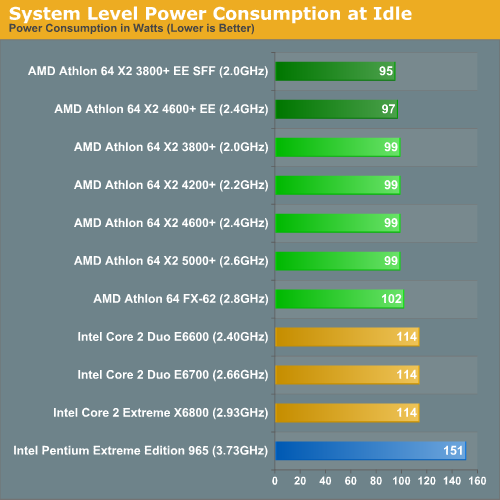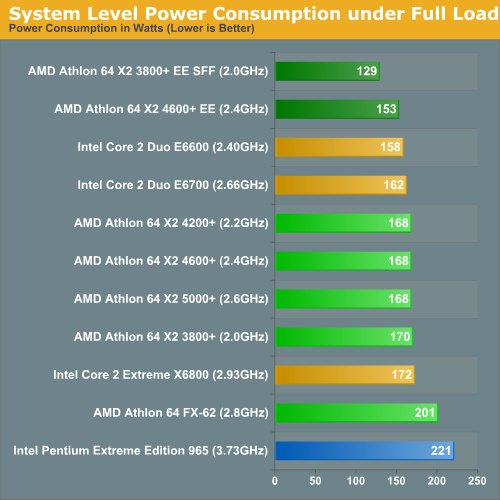Intel's Core 2 Extreme & Core 2 Duo: The Empire Strikes Back
by Anand Lal Shimpi on July 14, 2006 12:00 AM EST- Posted in
- CPUs
Power Consumption: Who is the king?
Intel promised us better performance per watt, lower energy consumed per instruction, and an overall serious reduction in power consumption with Conroe and its Core 2 line of processors. Compared to its NetBurst predecessors, the Core 2 lineup consumes significantly lower power - but what about compared to AMD?
This is one area that AMD is not standing still in, and just days before Intel's launch AMD managed to get us a couple of its long awaited Energy Efficient Athlon 64 X2 processors that are manufactured to target much lower TDPs than its other X2 processors. AMD sent us its Athlon 64 X2 4600+ Energy Efficient processor which carries a 65W TDP compared to 89W for the regular 4600+. The more interesting CPU is its Athlon 64 X2 3800+ Energy Efficient Small Form Factor CPU, which features an extremely low 35W rating. We've also included the 89W Athlon 64 X2s in this comparison, as well as the 125W Athlon 64 FX-62.
Cool 'n Quiet and EIST were enabled for AMD and Intel platforms respectively; power consumption was measured at the wall outlet. We used an ASUS M2NPV-VM for our AM2 platform and ASUS' P5W DH Deluxe for our Core 2 platform, but remember that power consumption will be higher with a SLI chipset on either platform. We used a single GeForce 7900 GTX, but since our power consumption tests were all done at the Windows desktop 3D performance/power consumption never came into play.
We took two power measurements: peak at idle and peak under load while performing our Windows Media Encoder 9 test.

Taking into consideration the fact that we were unable to compare two more similar chipsets (we will take a look back at that once retail Intel nForce 5 products hit the shelves), these power numbers heavily favor Intel. The releative power savings over the Extreme Edition 965 show just how big the jump is, and the ~15% idle power advantage our lower power AMD motherboard has over the Intel solution isn't a huge issue, especially when considering the performance advantage for the realtively small power investment.

When looking at load power, we can very clearly see that AMD is no longer the performance per watt king. While the Energy Efficient (EE) line of X2 processors is clearly very good at dropping load power (especially in the case of the 3800+), not even these chips can compete with the efficiency of the Core 2 line while encoding with WME9. The bottom line is that Intel just gets it done faster while pulling fewer watts (e.g. Performance/Watt on the X6800 is 0.3575 vs. 0.2757 on the X2 3800+ EE SFF).
In fact, in a complete turn around from what we've seen in the past, the highest end Core 2 processor is actually the most efficient (performance per Watt) processor in the lineup for WME9. This time, those who take the plunge on a high priced processor will not be stuck with brute force and a huge electric bill.










202 Comments
View All Comments
soydios - Friday, July 14, 2006 - link
Awesome article, as always from AT. Between the article and the 100+ comments above this one, almost all my Conroe questions have been answered.;)
johnsonx - Friday, July 14, 2006 - link
Wow is all I can say. I don't think there's ever been a performance jump quite like this. AMD will still do ok (not win mind you) on the low-end, where most people live, but the mid-range and high-end is so overwhelmingly in Intel's camp now there's just no comparison. AMD would have to go to 3.4Ghz+ to even be competitive (and still not win mind you).My office computers will continue to be AMD Sempron for the forseeable future (AM2 from now on of course), but next time someone wants a CAD box I don't see how I can quote anything but Core 2 Duo.
Also, loved the dinner table analogy on page 13.
crimson117 - Friday, July 14, 2006 - link
http://www.tgdaily.com/2006/07/13/dell_xps700_to_f...">http://www.tgdaily.com/2006/07/13/dell_xps700_to_f..."Grapevine (TX) - On the day Intel announces its next generation of Conroe desktop processors - which is expected within days - Dell Computer will upgrade its top-of-the-line XPS 700 desktop computer model to offer not only an overclocked Core 2 Extreme CPU, but also the option of two Nvidia GeForce 7900 GTX cards in SLI mode. These will apparently replace the Pentium Extreme processor and GeForce 7900 GS options currently available, and will be in addition to the Aegia PhysX accelerator already offered."
epsilonparadox - Friday, July 14, 2006 - link
Probably an Nf4 chipset since there are motherboards with conroe support using Nf4.Avalon - Friday, July 14, 2006 - link
This is one fine architecture. It wound up performing as well as I had suspected it would. Definitely wow.cgrecu77 - Friday, July 14, 2006 - link
I gambled by purchasing a A64 3700+ a few weeks ago when it dropped to under 150 ...If I were to upgrade to the cheapest solo I would probably have to pay 500 dollars or more (new cpu, mb and memory) and I will probably get ~ performance in games. I stopped overclokcing a long time ago (except for maybe 10%) because I am tired of my new system becoming unstable after 4 months (plus I don't really need it anymore since nothing I do is really cpu limited).
98% of people actually buy the cheapest CPUs in a range (A64 2800-3200, x2 3800, C6300). That's where the real competition will be and frankly I'm not impressed at all, A64 is an ~3years old processor and intel's newest product can only beat it by 20%? As far as I can remember the Athlon 3200+ was even worse in comparison to P4 3,2 Ghz and most people still bought the 2500+ Bartons ... So I wouldn't worry too much if I were an AMD stock holder, especially that it looks like Opterons still have no competition in the multi cpu servers (more than 2 ...).
After all, if Dell decided to use AMD NOW of all times it must mean something, they probably had access to these benchmarks a little earlier than Anand had ... :)
One thing I would have expected to see for such a new CPU that is supposed to carry the Intel flag for the next 2 years is 64 bit performance. This is probably the last year when 32bit OSes have the upper hand, starting with Vista most people will take advantage of their 64bit cpus. Once the majors concentrate on 64 bit drivers you can be sure that they will gradually take resource from the 32 bit development and the balance will shift very quickly ... If A64 has even a 10% advantage over the Cores combined with the .65 switch it will probably balance the equation to the point where core and a64 will have similar performance per clock ...
dargaard - Saturday, July 15, 2006 - link
http://babelfish.altavista.com/babelfish/trurl_pag...">Some Conroe problems (??) with 64 bitdev0lution - Friday, July 14, 2006 - link
First off, why mention Core Solo when it's totally unrelated to this article and any of the comments?
Second, socket 939's days are already numbered. You'd have to pay the same $500 to upgrade to the AM2 processors benched in the article, so mentioning this as a diss to Core 2 Duo is pretty weak.
So you'd have the option of spending $500 to upgrade to a E6600 setup that would beat out a $1200+ AM2 setup. Sounds like a no-brainer. And if you think AMD's going to slash prices below Intel's parts I don't think you can hold your breath that long.
And 98% of people don't even build their own computers, they buy tier-1... who aren't making nearly that percentage of their systems with the lowest end parts.
Looks like I'll have a 3200, 3700 and 4000 (939 parts) for sale in the near future...
MrKaz - Monday, July 17, 2006 - link
OK.But if you dont want to spent more than 120$ for the processor, the Conroe looks expensive.
aznskickass - Friday, July 14, 2006 - link
Dude, 20% is a HUGE margin when you are talking competitive benchmarks.When A64 was released back in 2003 it had about a 10% edge on the P4 and people were lauding it for it's leap in performance, and rightly so, considering the AXPs were getting beaten by 10%, so it was a 20% turnaround altogether.
This time around, it's even more impressive from Intel as they have turned a 10 - 20% performance deficit into a 20% advantage, you really can't expect much more than that, can you?
What did you expect Intel to do, double A64 performance? I'm sure if they ran their chips @ 4GHz/400FSB they might be able to get close to that, but what is the point when you have beaten your competition so convincingly already?